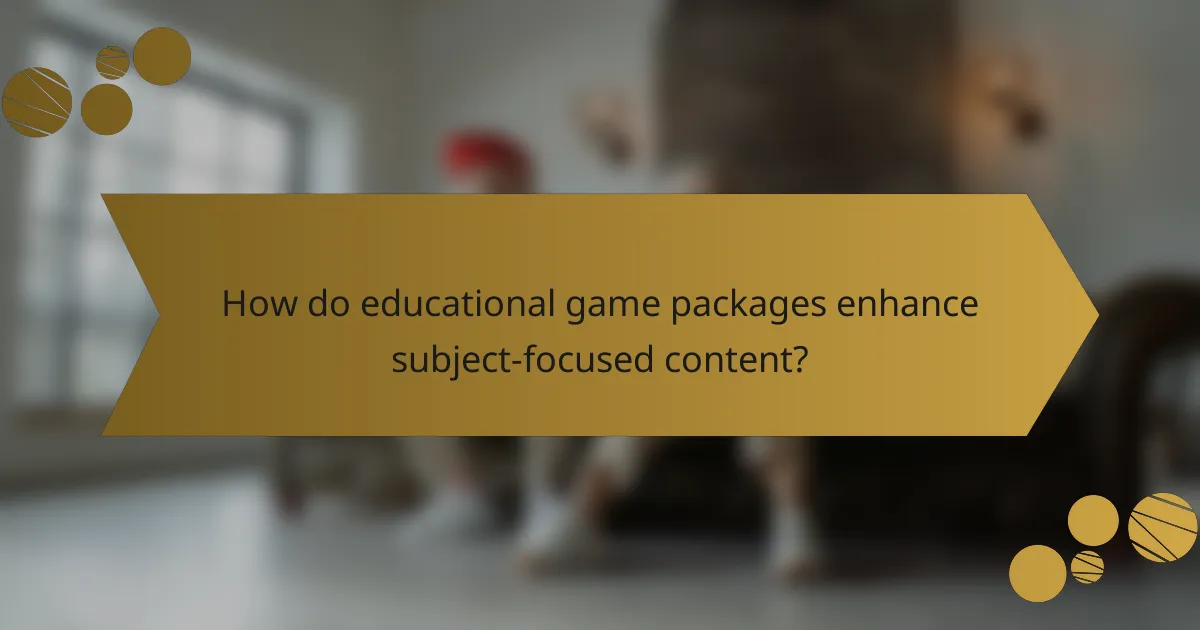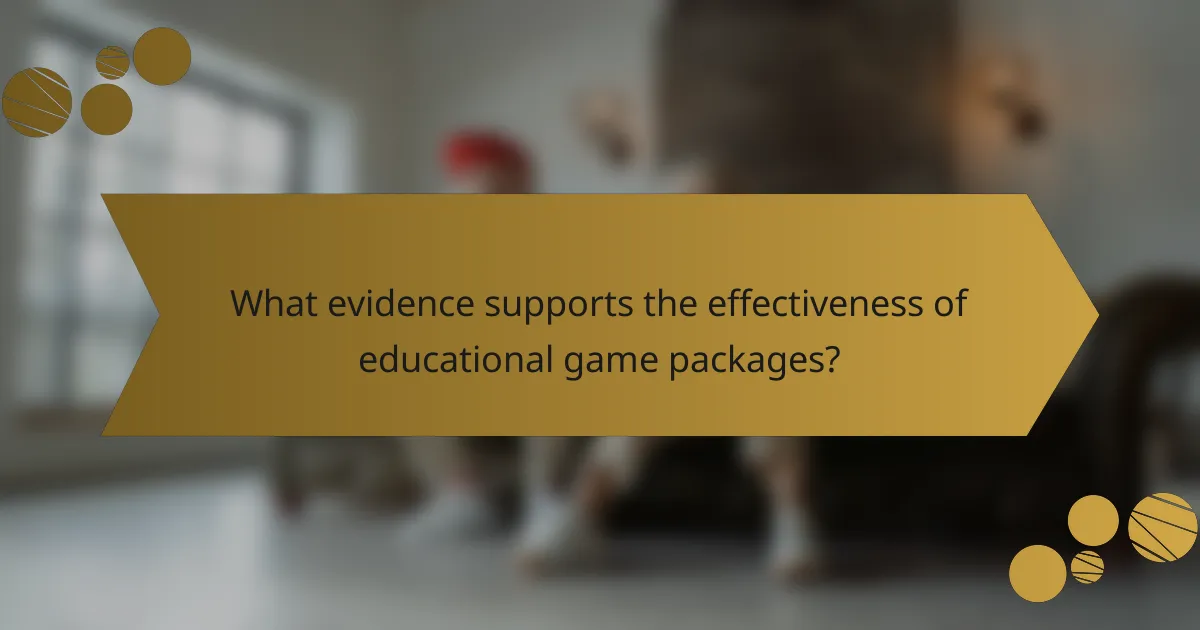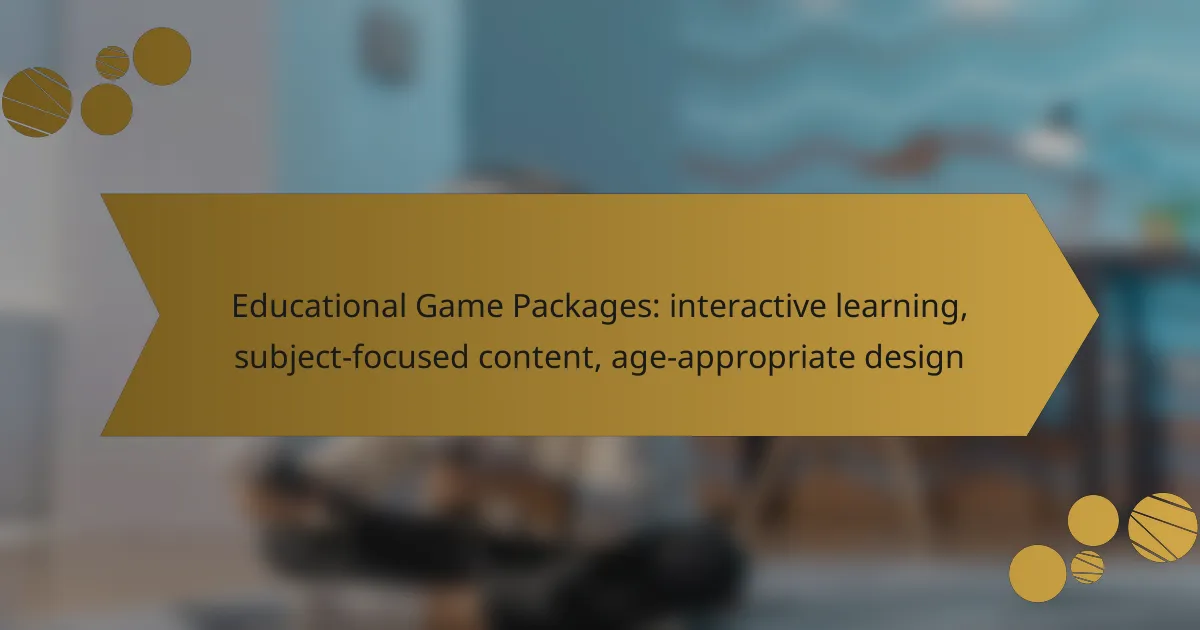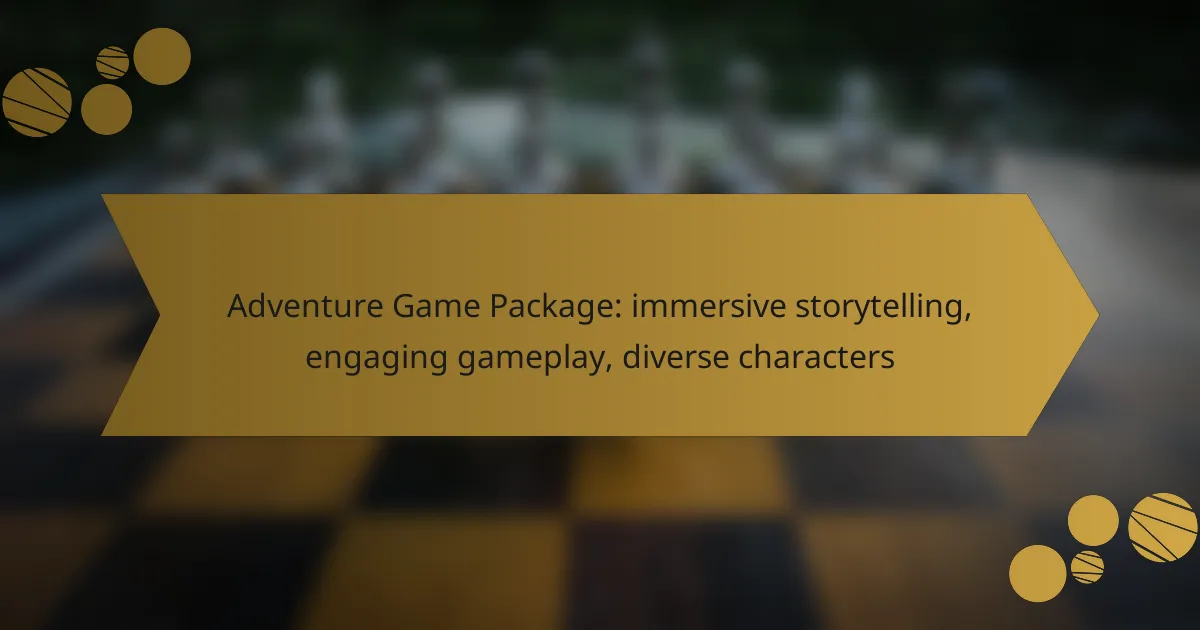Educational game packages offer an innovative approach to interactive learning by merging engaging gameplay with subject-focused content tailored for different age groups. These resources not only promote critical thinking and problem-solving skills but also enhance the learning experience through hands-on activities and digital resources. With age-appropriate designs, these games ensure that content is both engaging and suitable for children’s developmental stages, making learning enjoyable and effective.

What are the best educational game packages for interactive learning in the UK?
The best educational game packages for interactive learning in the UK combine engaging gameplay with subject-focused content tailored for various age groups. These packages enhance learning through interactive experiences that promote critical thinking and problem-solving skills.
Osmo Genius Starter Kit
The Osmo Genius Starter Kit is designed for children aged 6 to 12 and integrates physical play with digital learning. It includes interactive games that cover subjects like math, spelling, and creativity, using a tablet and a special base that recognizes physical objects.
Consider the Osmo’s hands-on approach, which encourages collaboration and communication among players. The kit typically retails for around £100, making it a worthwhile investment for parents seeking to enhance their child’s learning experience.
LeapFrog LeapStart
The LeapFrog LeapStart is an interactive learning system aimed at preschool and early primary school children, focusing on subjects such as reading, math, and science. It uses activity books that come to life with audio and interactive features when paired with the LeapStart device.
This package is ideal for children aged 2 to 7 and is priced around £50 to £70. The LeapStart’s structured learning paths allow parents to track progress, ensuring that children develop essential skills at their own pace.
ThinkFun Gravity Maze
ThinkFun Gravity Maze is a unique game that combines logic and engineering skills for children aged 8 and up. Players build a marble run using various pieces to solve challenges, promoting spatial reasoning and problem-solving abilities.
This game typically costs between £30 and £40 and includes multiple challenge cards to keep players engaged. It’s an excellent choice for parents looking to encourage STEM learning in a fun and interactive way.

How do educational game packages enhance subject-focused content?
Educational game packages enhance subject-focused content by providing interactive and engaging experiences that align with specific learning objectives. These packages often incorporate hands-on activities and digital resources tailored to various subjects, making learning more effective and enjoyable for students.
STEM Learning with LEGO Education
LEGO Education offers a range of products designed to promote STEM learning through hands-on building and programming activities. Students can explore concepts in science, technology, engineering, and mathematics by constructing models and engaging in problem-solving tasks. This approach not only fosters creativity but also helps develop critical thinking skills.
When using LEGO Education, consider age-appropriate sets that align with curriculum standards. For younger learners, simpler kits that focus on basic engineering principles are ideal, while older students can tackle more complex robotics projects. Incorporating these tools into the classroom can significantly enhance student engagement and understanding of STEM subjects.
Reading Comprehension with Reading Eggs
Reading Eggs is an interactive online program designed to improve reading comprehension for children. It combines engaging games, activities, and e-books that cater to various reading levels, making it suitable for early learners and those needing extra support. The platform adapts to each child’s progress, ensuring personalized learning experiences.
To maximize the benefits of Reading Eggs, encourage regular practice and set achievable goals for your child. Aim for short, consistent sessions, ideally 15-30 minutes a few times a week. This approach helps reinforce skills without overwhelming young learners, making reading a fun and rewarding activity.

What age-appropriate designs are available for educational games?
Age-appropriate designs for educational games cater to the developmental stages of children, ensuring that content is engaging and suitable for their cognitive abilities. These designs typically incorporate interactive elements, colorful visuals, and intuitive navigation to enhance learning experiences.
Games for preschoolers: ABCmouse
ABCmouse is a popular educational platform designed specifically for preschoolers, offering a comprehensive curriculum that covers subjects like reading, math, art, and science. The game features interactive activities, songs, and stories that are tailored to engage young learners.
When using ABCmouse, parents should consider the age range of 2 to 8 years, as the content is structured to support early childhood development. The platform encourages exploration through a reward system, which helps maintain motivation and interest.
Games for primary school: Prodigy Math
Prodigy Math is an engaging game aimed at primary school students, focusing on math skills through a fantasy-based adventure. Players solve math problems to progress through levels, making learning fun and interactive.
This game is suitable for children in grades 1 to 8 and adapts to individual learning levels, providing personalized challenges. Parents should monitor their child’s progress and ensure they are balancing game time with other educational activities.

What criteria should be considered when selecting educational game packages?
When selecting educational game packages, consider factors such as age suitability, curriculum alignment, and the overall design to ensure they effectively engage learners and meet educational goals. These criteria help in choosing games that are not only enjoyable but also beneficial for skill development.
Age suitability
Age suitability is crucial in selecting educational game packages, as games designed for specific age groups enhance engagement and learning. For example, games for younger children often feature bright colors and simple mechanics, while those for older students may incorporate more complex strategies and themes.
To determine age appropriateness, check the recommended age range provided by the game developers. Look for games that challenge without overwhelming the player, ensuring that content is relatable and accessible for the intended age group.
Curriculum alignment
Curriculum alignment ensures that educational game packages support specific learning objectives and standards. Games that are closely tied to the curriculum can reinforce classroom learning and provide practical applications of concepts taught in school.
When evaluating curriculum alignment, consider whether the game covers relevant subjects and skills, such as math, science, or language arts. Review the game’s content against local educational standards to confirm it meets necessary benchmarks for your region.

How do digital educational game packages compare in pricing?
Digital educational game packages vary significantly in pricing based on their structure, such as monthly subscriptions or one-time purchases. Understanding these pricing models can help you choose the best option for your educational needs and budget.
Monthly subscriptions
Monthly subscriptions typically range from around $5 to $30 per month, depending on the platform and the content offered. This model allows users to access a wide array of games and updates regularly, which can be beneficial for ongoing learning.
When considering a subscription, evaluate the number of subjects covered and the age appropriateness of the content. Some platforms may offer free trials, allowing you to test the service before committing.
One-time purchases
One-time purchases for educational game packages usually cost between $10 and $100, depending on the complexity and depth of the content. This model provides permanent access to the purchased games, making it a good option for those who prefer not to deal with recurring fees.
Before buying, check if the package includes updates or additional content, as some may require extra fees for future enhancements. This can influence the overall value of your investment in educational resources.

What evidence supports the effectiveness of educational game packages?
Educational game packages have been shown to enhance learning outcomes by increasing student engagement and motivation. Research indicates that interactive and subject-focused content can lead to improved retention and understanding of material among learners of various ages.
Research studies on engagement
Numerous studies highlight the positive impact of educational games on student engagement. For instance, research has found that students participating in game-based learning often exhibit higher levels of interest and participation compared to traditional methods. These games can cater to different learning styles, making them effective for a diverse student population.
One study noted that game-based learning environments can increase time on task, with students spending significantly more time engaged with content. This extended engagement often correlates with better academic performance and deeper comprehension of the subject matter.
Case studies from UK schools
Several UK schools have implemented educational game packages with notable success. In one instance, a primary school reported a 30% increase in math scores after integrating interactive math games into their curriculum. Teachers observed that students were more motivated to participate and showed improved problem-solving skills.
Another case study from a secondary school highlighted the use of a history-focused game package that led to enhanced critical thinking among students. Feedback from both students and educators indicated that the game not only made learning enjoyable but also facilitated better discussions and understanding of historical events.

What emerging trends are shaping the future of educational game packages?
Emerging trends in educational game packages focus on enhancing interactive learning through advanced technology, subject-specific content, and designs tailored for different age groups. These trends aim to create engaging and effective learning experiences that cater to diverse educational needs.
Integration of AI in learning games
The integration of artificial intelligence (AI) in learning games is revolutionizing how educational content is delivered. AI can personalize learning experiences by adapting difficulty levels and content based on individual student performance, ensuring that each learner progresses at their own pace.
For instance, AI-driven games can analyze a student’s responses and provide instant feedback, helping to identify areas where they may need additional practice. This adaptive learning approach not only enhances engagement but also improves retention rates, making the educational process more effective.
When selecting educational games with AI features, consider the balance between personalization and the potential for over-reliance on technology. Ensure that the game encourages critical thinking and problem-solving skills rather than merely providing answers. Look for games that incorporate a variety of subjects and age-appropriate challenges to maintain interest and promote comprehensive learning.

